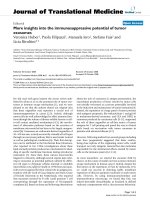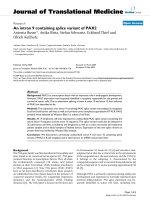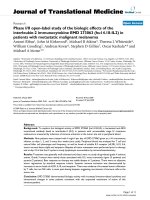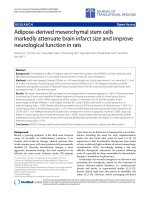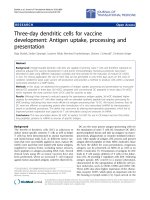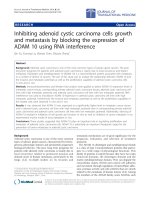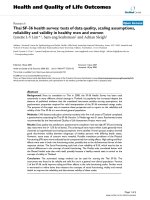Báo cáo hóa học: "Platinum Assisted Vapor–Liquid–Solid Growth of Er–Si Nanowires and Their Optical Prope" potx
Bạn đang xem bản rút gọn của tài liệu. Xem và tải ngay bản đầy đủ của tài liệu tại đây (352.65 KB, 5 trang )
NANO EXPRESS
Platinum Assisted Vapor–Liquid–Solid Growth of Er–Si
Nanowires and Their Optical Properties
Myoung-Ha Kim
•
Il-Soo Kim
•
Yong-Hee Park
•
Tae-Eon Park
•
Jung H. Shin
•
Heon-Jin Choi
Received: 27 August 2009 / Accepted: 28 October 2009 / Published online: 14 November 2009
Ó to the authors 2009
Abstract We report the optical activation of erbium
coated silicon nanowires (Er–SiNWs) grown with the assist
of platinum (Pt) and gold (Au), respectively. The NWs
were grown on Si substrates by using a chemical vapor
transport process using SiCl
4
and ErCl
4
as precursors. Pt as
well as Au worked successfully as vapor–liquid–solid
(VLS) catalysts for growing SiNWs with diameters of
*100 nm and length of several micrometers, respectively.
The SiNWs have core–shell structures where the Er-
crystalline layer is sandwiched between silica layers.
Photoluminescence spectra analyses showed the optical
activity of SiNWs from both Pt and Au. A stronger Er
3?
luminescence of 1,534 nm was observed from the SiNWs
with Pt at room- and low-temperature (25 K) using the
488- and/or 477-nm line of an Ar laser that may be due to
the uniform incorporation of more Er ions into NWs with
the exclusion of the formation of catalyst-induced deep
levels in the band-gap. Pt would be used as a VLS catalyst
for high performance optically active Er–SiNWs.
Keywords Si nanowires Á Erbium Á Luminescence Á
Platinum catalyst
Introduction
Interest lies in developing an efficient silicon (Si)-based
light emitting material that enables the integration of
photonics with Si technology. In this regard, studies have
demonstrated some approaches to achieve luminescence
from Si [1, 2]. For example, Si nanocrystals (Si-ncs) in Si-
rich Si-oxide (SRSO) emit visible luminescence and sug-
gest the possibility of their use as a Si-based optoelectronic
device. In particular, the erbium (Er) doping of Si has
attracted attention as it can allow the realization of a Si-
based light emitter in the technologically important 1.5 lm
range [2, 3]. Excellent optical properties were obtained by
using SRSO, which consists of nano-cluster Si (nc-Si)
embedded inside a SiO
2
matrix [4–7]. However, the iso-
lation of nc-Si inside the SiO
2
matrix makes current
injection into SRSO difficult. Thus, SRSO-based light
emitting diodes (LEDs) generally require either very high
voltage or very thin SRSO layers that can limit the light
output [8–10].
Such problems may be solved by using Si nanowires
(SiNWs) instead [10]. NWs offer thermodynamically stable
features and have ultra high aspect ratio with single crys-
talline, thereby possessing a number of advantages over thin
films with respect to Si-based photonic devices [9–11]. A
large surface area to active activation volume ratio is
another advantage of NWs as a better light emitter at the
wavelength of 1.54 lm. Our previous studies have shown
that the optical activation of SiNWs is feasible by surface-
coating with Er-doped silica [10] or the formation of
Si/Er
2
Si
2
O
7
/SiO
2
core–shell NWs in an in-situ mode [11].
Optical characterization indicates that these Er–SiNWs have
potential as a new material platform for Si-based photonics.
The optically active Er–SiNWs in the previous studies
were grown by a vapor–liquid–solid (VLS) mechanism
M H. Kim Á I S. Kim Á Y H.Park Á T E. Park Á H J. Choi (&)
Department of Materials Science and Engineering,
Yonsei University, Seoul 120-749, Korea
e-mail:
J. H. Shin
Department of Physics, Korea Advanced Institute of Science and
Technology (KAIST), 373-1 Guseong-dong, Yuseong-gu,
Daejeon, Korea
123
Nanoscale Res Lett (2010) 5:286–290
DOI 10.1007/s11671-009-9477-5
with the assist of Au as a catalyst. In fact, Au has been
exclusively used as VLS catalyst for SiNWs. Meanwhile,
recent studies indicated that Au atoms could remain in the
NWs [12, 13]. Unfortunately, Au is deep-level impurities
in Si, and, thus, may harm the optical properties of
Er–SiNWs [14, 15]. Herein, we report on the optical acti-
vation of Er–SiNWs grown with Pt as a VLS catalyst. We
investigated Pt because it does not make deep level in the
Si band-gap and, thus, will not degrade the optical prop-
erties of Er–SiNWs [15–17]. Our investigation showed that
Pt works successfully as a VLS catalyst for Er–SiNWs. Pt
also enables better optical properties than those of
Er–SiNWs grown with Au.
Experimental Procedure
We synthesized vertically aligned Er–SiNWs on Si (111)
substrates coated with Pt or Au (for comparison) as a
VLS catalyst by a CVD process employing Si tetrachlo-
ride (SiCl
4
, Alfa, 99.999%) as the Si source [18]. Erbium
trichloride (ErCl
3
, Aldrich, 99.9%) powder placed in
quartz susceptor was inserted into the center of a quartz
tube at intervals of 1 in. The substrates were also placed
in the quartz tube at a distance of 1 in. from the ErCl
3
powders. Carrier gas transfers the source precursor
through a bubbler to the quartz reactor, and H
2
is then
introduced into the system at a flow rate of 20 sccm. H
2
(100 sccm) and Ar (100 sccm) gas were used as diluent
gases, which regulate the concentration of the mixture
containing SiCl
4
vapor and carrier gas. Typically, the
system was heated to 900–1,000 °C and maintained for
30 min as the flow of SiCl
4
then cooled to room tem-
perature. We observed the NWs by using a scanning
electron microscope (SEM) and transmission electron
microscopy (TEM). The photoluminescence (PL) spectra
were measured using either the 488- and/or 477-nm line
of an Ar laser, a grating monochromator, a thermoelec-
trically cooled InGaAs diode, and the standard lock-in
technique. The low-temperature measurements were made
using a closed-cycle cryostat.
Results and Discussion
Figure 1a, b shows an SEM image of SiNWs grown on the
substrate. The NWs vertically grew with the diameter
ranging from 80 to 150 nm and lengths of *10 lm,
respectively. It is known that the epitaxial relationship
between the substrate and NWs attributes to the vertical
growth of NWs [19] and, thus, both catalysts should yield
epitaxial interfaces between the NWs and substrate. The
inset images show the liquid globules at the tips of the
NWs, indicating the success of both metals as a VLS cat-
alyst [18].
Figure 1c is a typical TEM image of an individual Er–
SiNW grown with Pt. The outer sheath of the NWs consists
Fig. 1 SEM images of Er–SiNWs grown with a Pt- and b Au-
catalyst. Inset shows the alloy globule at the tip of Er–SiNWs. c TEM
image of an individual Er–SiNW grown with Pt, showing the core–
shell structure with shell layer conducted with \2 nm Er-rich
crystalline layer within amorphous SiO
x
layer. Inset shows HR-
TEM image of SiNWs showing the single crystalline nature of Er–
SiNWs with Er-crystalline layers with 1–2 nm within amorphous
SiO
x
shell
Nanoscale Res Lett (2010) 5:286–290 287
123
of a trilayer with nanometer-thin shells. An energy dis-
persive spectroscopy (EDS) analysis of the surface region
indicates the presence of Er, Si, and O in the surface layer,
and a high-resolution TEM image of the surface region
shows the presence of a single-crystalline layer sandwiched
between nanometer-thin amorphous silica shells (Fig. 1c).
This core–shell structure is the same as the structures of the
Er–SiNWs with the Au catalyst that we have reported [11].
It indicates that both Pt and Au catalyst work as catalysts
for core–shell structure Er–SiNWs. The formation of core–
shell structures in a one-step fabrication process implies
that the heterostructure is formed via a self organization
process by a spontaneous phase separation in the Er–Si–O
alloy system. As suggested in our previous study, the for-
mation of the core–shell seems driven by the different
solubility of Er between liquid catalyst and solid NWs. In
the VLS mechanism, both Si and Er are supplied to the
catalyst in supersaturation. Since Er and Si have solubility
to Pt or Au [20, 21], respectively, Er can precipitate at the
interface between the catalyst and the growing NWs.
However, Er has an extremely low solubility in Si due to
large atomic size and is thus segregated to the surface in
the Er-crystalline phase [22].
Figure 2 shows the PL spectra of the Er–SiNWs array
measured at room temperature using the 488- and/or
477-nm line of an Ar laser. The 488-nm line is directly
absorbed by Er
3?
ion, and the 477-nm line is absorbed
only by SiNWs and not directly by Er
3?
ion. Figure 2a
shows the PL spectra of the Er–SiNWs using the 488-nm
line. Both NWs emitted a spectrum centered at 1,534 nm.
This indicates that Er
3?
ions are successfully incorporated
into the NWs, as proposed by previous studies [6–11]. The
intensity from NWs with Pt was approximately two times
higher than that of Au. The intensity of the luminescence
spectrum from Er
3?
ions primary depends on the Er
content under characterization. As shown in Fig. 1, the
density of Er–SiNWs with Pt (1.89 9 10
7
/cm
2
) was lower
than that of NWs with Au (2.56 9 10
7
/cm
2
). Therefore,
the stronger intensity in Er–SiNWs with Pt may be due to
the incorporation of more Er ions into NWs. In fact, the
core–shell structure of both Er–SiNWs is almost the same
as c.a. 1 nm of Er-layers. Thus, the amount of Er incor-
porated into individual NWs would be almost the same.
Meanwhile, we found in the course of characterization that
the Er–SiNWs samples with Pt showed the more homo-
geneous optical activity through the area under investi-
gation. This implies that Pt produced Er–SiNWs more
uniformly over the substrate and is ascribed to the stronger
intensities.
Figure 2b shows the PL spectra using the 477-nm line.
A luminescence appeared centered at 1,530 nm from the
SiNWs, indicating an energy transfer from the SiNWs to
the Er
3?
ions in both cases [10]. In the case of 477-nm line,
the intensity of the PL spectrum from the NWs with Pt is
approximately three times stronger than with Au. This
implies that, in addition to the incorporation of more Er
ions into NWs, a more efficient energy transfer occurs in
Er–SiNWs grown with Pt. The results shown in Fig. 2,
thus, indicate that Pt enables the preparation of optically
more active Er–SiNWs by incorporating Er
3?
ions uni-
formly and more efficient energy transfer from NWs to
Er
3?
ions.
It is difficult to clearly address why more Er ions are
uniformly incorporated into SiNWs with Pt than that with
Au because it happens in a complex VLS process. Three
phases, two interfaces (that is, vapor–liquid and liquid–
solid interfaces), and chemical reactions are involved [23]
in the VLS process. In terms of kinetics, it consists of four
main steps: (1) mass-transport in the gas phase, (2)
chemical reaction on the vapor–liquid interface, (3) diffu-
sion in the liquid phase, and (4) incorporation of atoms in a
crystal lattice [18, 23–25]. Nevertheless, an explanation
Fig. 2 The PL spectra of the Er–SiNWs array with Pt and Au,
respectively, measured at room temperature using the a 488- and/or
b 477-nm line of an Ar laser
288 Nanoscale Res Lett (2010) 5:286–290
123
may be possible. According to the kinetics of the VLS
process [23] and our previous study on the formation of Er
shells on the SiNWs [11], the mechanism of incorporation
of Er into the NWs could be schemed as dissolving Er into
liquid catalyst and precipitates on the surface of NWs [11,
22]. In this mechanism, the amount of Er
3?
ions incorpo-
rated into NWs may relate to the difference of solubility of
Er for liquid Si in catalyst compare to that for solid Si in
NWs. Meanwhile, Si-rich globule was formed when using
the Pt catalyst, while an Au-rich globule was formed when
using the Au catalyst [18]. This compositional difference
may be the differential solubility of Si in Pt and Au.
Specifically, the solubility of Si in Au is 18.6 at.% [9],
whereas in Pt it is as high as 67 at.% [26] at their eutectic
points. Therefore, it is possible that the Pt catalyst under a
liquid state has a Si-rich composition. Since the incorpo-
ration of Er into NWs through catalyst is related to the
difference in solubility of Er between liquid and solid Si in
catalyst and NWs, respectively [11], Pt catalyst that can
dissolve the more Si as compare to Au catalyst could
incorporate the more Er into SiNWs.
Meanwhile, the more efficient energy transfer may
relate to the contamination of the catalyst component in
the SiNWs. Recent studies have indicated that Au can be
incorporated into NWs in the course of VLS growth [12,
13] and, thus, Pt would do. Figure 3 illustrates the energy
transfer mechanism for the activation of Er
3?
ions in the
Er–SiNWs by 477-nm line. Figure 3a illustrates the
energy transfer from SiNWs to Er
3?
ion without trap
levels in the NWs. The SiNWs absorbs the photon energy
from 477-nm line, and the electrons excite from the
valence band (VB) to the conduction band (CB). Then,
the recombination of the electrons in the CB with holes in
the VB yields emissions of *0.8 eV. Since the 0.8 eV
energy couples well with the
4
I
13/2
level of the Er, energy
transfers to the Er ions and excites it. Since Pt does not
form deep level in the Si band-gap, it does not hinder the
energy transfer illustrated in Fig. 3a, even if it exists in
the NWs. In fact, Pt forms trap level at E
v
?0.03 eV and
E
c
-0.23 eV a donor and /or acceptor level in Si [17];
however, it does not hinder the energy transfer to activate
the Er
?3
ions. On the other hand, Au forms two deep trap
levels in Si. The two Au-related trap levels at energies of
E
v
?0.35 eV and E
v
?0.53 eV were identified as a donor
and an acceptor level, respectively [14]. As illustrated in
Fig. 3b, the trap levels absorb the energy that should
transfer from Si to Er
?3
ions and would degrade the
optical properties.
Figure 4 shows the PL spectrum of the Er–SiNWs
measured at 25 K using the 488-nm line of an Ar laser.
A typical Er
3?
luminescence centering around 1,534 nm
was observed. The spectral width of observable peaks is
limited by the system resolution, which was 1.5 nm. It is
noted that some additional luminescent peaks located
at 1,530, 1,534, 1,542, 1,547, 1,561, and 1,563 nm,
respectively, appear for the Er–SiNWs with Pt. As the
intra-4f transition of rare earth ions are forbidden tran-
sitions that are allowed because of parity mixing by the
crystal field, such sharp, well-defined peaks as seen in
Fig. 4 indicate that the Er
3?
ions are located in well-
defined sites in a crystalline environment [22], as shown
in Fig. 1c.
Fig. 3 Schematic of the energy transfer mechanisms of Er–SiNWs
a without deep level and b with deep level possibly induced by Au
Fig. 4 The PL spectrum of the Er–SiNWs array grown with Pt
catalyst measured at 25 K using the 488-nm line of an Ar laser. The
inset shows the PL spectrum of the Er–SiNWs grown with Au catalyst
Nanoscale Res Lett (2010) 5:286–290 289
123
Conclusion
In summary, we vertically grew Er–SiNWs with the
assistance of Pt as a VLS catalyst. The Er–SiNWs showed
stronger luminescence at 1,530 nm wavelength at low- and
room-temperature than did the Er–SiNWs with Au. The
outcomes indicate that Pt is an excellent candidate as a
VLS catalyst for optically more active Er–SiNWs. It was
noted that SiNWs in most cases are prepared with the
assistance of Au as a VLS catalyst, which may be harmful
for their electrical as well as optical properties. Therefore,
our results suggest that Pt can be used for SiNWs with
improved electrical as well as optical properties.
Acknowledgments This research was supported by a grant from the
National Research Laboratory program (R0A-2007-000-20075-0),
Pioneer research program (2009-008-1529) for converging technol-
ogy through the Korea Science and Engineering Foundation funded
by the Ministry of Education, Science & Technology and the IT R&D
program of MKE/KEIT [2008-F-023-01].
References
1. H. Ennen, J. Schneider, G. Pomrenke, A. Axman, Appl. Phys.
Lett. 43, 943 (1983)
2. L. Ren, W.Y. Jeung, H.J. Choi, Appl. Surf. Sci. 253, 8885 (2007)
3. B. Jalali, S. Fathpour, J. Lightwave. Technol. 24, 4600 (2006)
4. A.J. Kenyon, P.F. Trwoga, M. Federighi, C.W. Pitt, J. Phys.
Condens. Matter 6, L319 (1994)
5. M. Fujii, M. Yoshida, Y. Kanazawa, S. Hayashi, K. Yamamoto,
Appl. Phys. Lett. 71, 1198 (1997)
6. J.H. Shin, M.J. Kim, S.Y. Seo, C. Lee, Appl. Phys. Lett. 72, 1092
(1998)
7. A. Irrera, D. Pacifici, M. Miritello, G. Franzo, F. Priolo, F.
Iacona, D. Sanfilippo, G. Di Stefano, P.G. Fallica, Appl. Phys.
Lett. 81, 1866 (2002)
8. A. Polman, G.N. Hoven, J.S. Custer, J.H. Shin, R. Sema, P.F.A.
Alkemade, J. Appl. Phys. 77, 1256 (1995)
9. K. Suh, J.H. Shin, S.J. Seo, B.S. Bae, Appl. Phys. Lett. 89,
223102 (2006)
10. K. Suh, J.H. Shin, O.H. Park, B.S. Bae, J.C. Lee, H.J. Choi, Appl.
Phys. Lett. 86, 053101 (2005)
11. H.J. Choi, J.H. Shin, K. Suh, H.K. Seong, H.C. Han, J.C. Lee,
Nano Lett. 5, 2432 (2005)
12. J.B. Hannon, S. Kodambaka, F.M. Ross, R.M. Thomp, Nature
440, 69 (2006)
13. S.H. Oh, K. Benthem, S.I. Molina, A.Y. Borisevich, W. Luo,
P. Werner, N.D. Zakharov, D. Kumar, S.T. Pantelides,
S.J. Pennycook, Nano Lett. 8, 1016 (2008)
14. N.F. Will, K. Hofmann, M. Schulz, Appl. Phys. A 41, 107 (1986)
15. E.C. Garnett, W. Liang, P. Yang, Adv. Mater. 19, 2946 (2007)
16. P.K. Sekhar, S.N. Sambandam, D.K. Sood, S. Bhansali, Nano-
technology 17, 4606 (2006)
17. A.O. Evwaraye, E. Sun, J. Appl. Phys. 47, 3172 (1976)
18. H. Jeong, T.E. Park, H.K. Seong, M. Kim, U. Kim, H.J. Choi,
Chem. Phys. Lett. 467, 331 (2009)
19. M.H. Huang, S. Mao, H. Feick, H. Yan, Y. Wu, H. Kind,
E. Weber, R. Russo, P. Yang, Science 292, 1897 (2001)
20. H. Okamoto, J. Phase Equilib. Diff. 28, 486 (2007)
21. B. Predel, Numerical Data and Functional Relationships in
Science and Technology, 5th edn. (Springer, Berlin, 1995)
22. Y.S. Tang, K.C. Heasman, W.P. Gillin, B.J. Sealy, Appl. Phys.
Lett. 55, 432 (1989)
23. E.I. Givargizov, J. Cryst. Growth 31, 20 (1975)
24. T.I. Kamins, R.S. Williams, D.P. Basile, T. Hesjedal, J.S. Harris,
J. Appl. Phys. 89, 1008 (2001)
25. J. Kikkawa, Y. Ohno, S. Takeda, Appl. Phys. Lett. 86, 123109
(2005)
26. T. Massalski, J. Murray, L. Bennett, H. Baker, Binary Alloy
Phase Diagrams (American Society for Materials, Florida, 1986)
290 Nanoscale Res Lett (2010) 5:286–290
123
